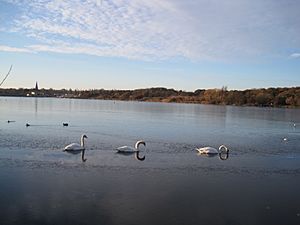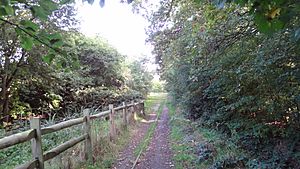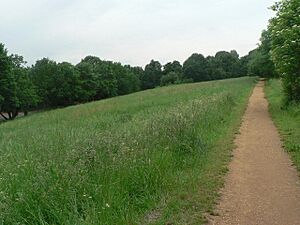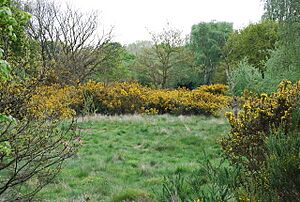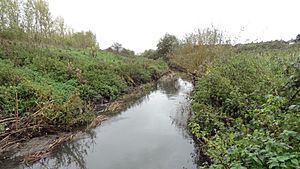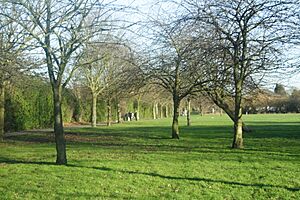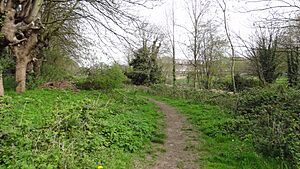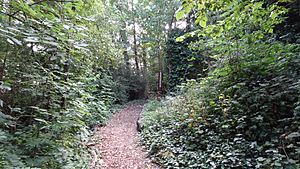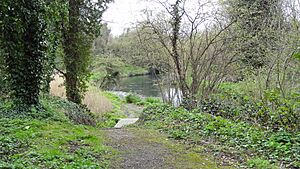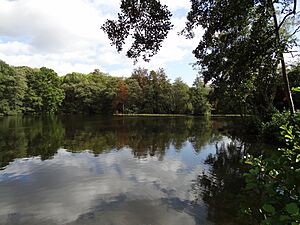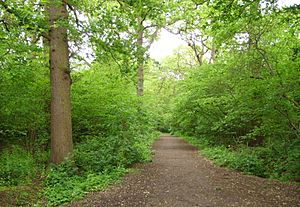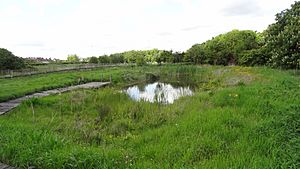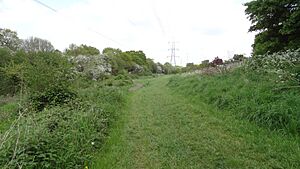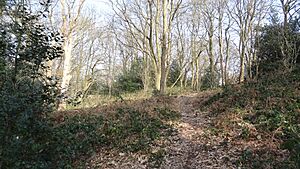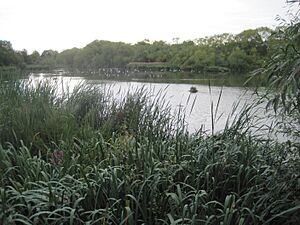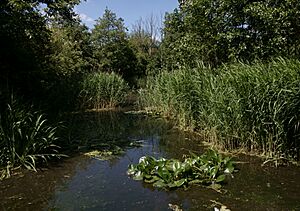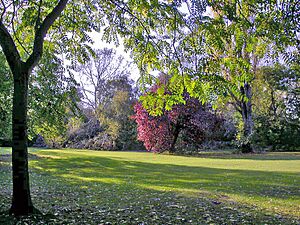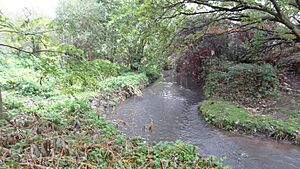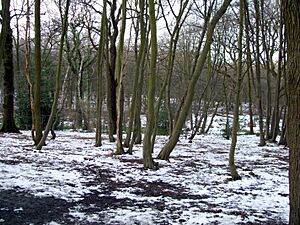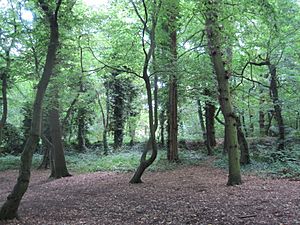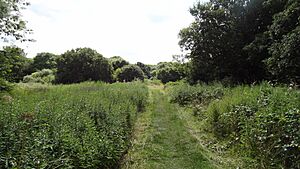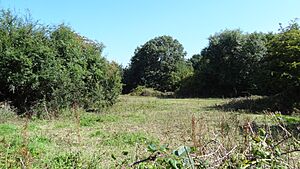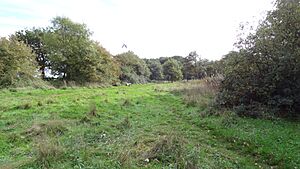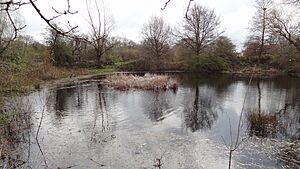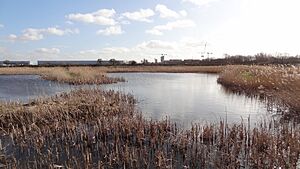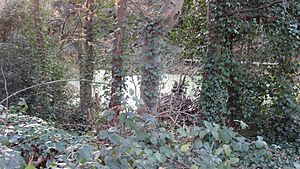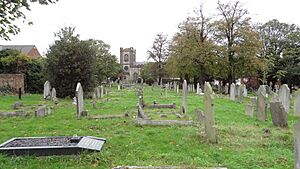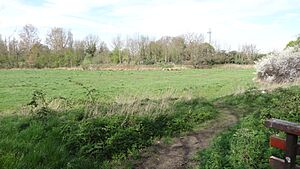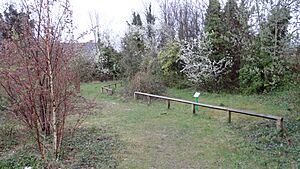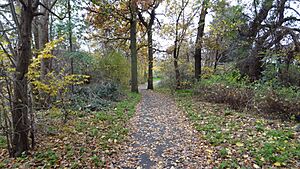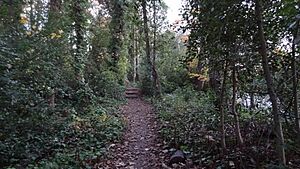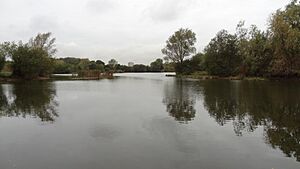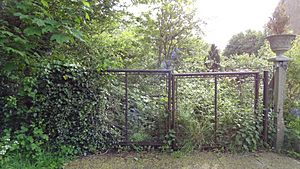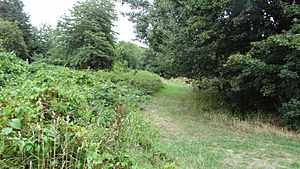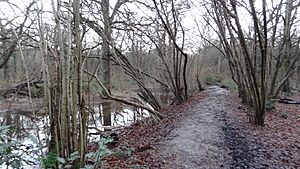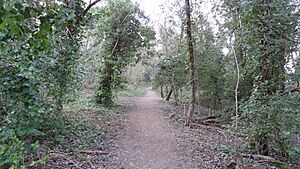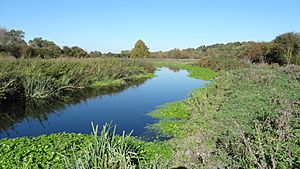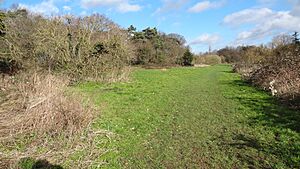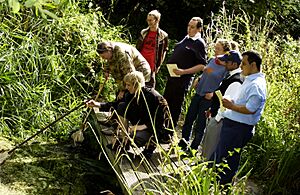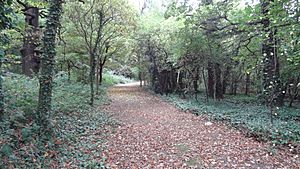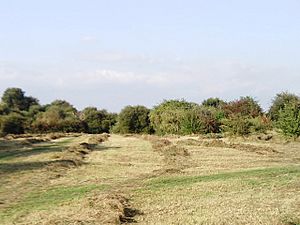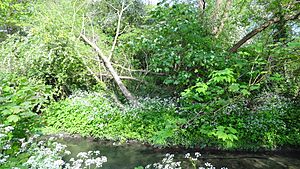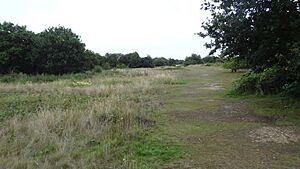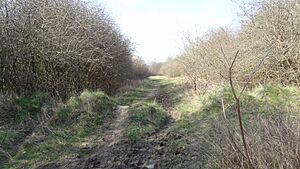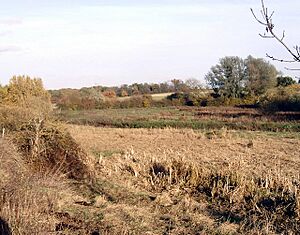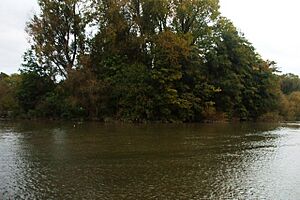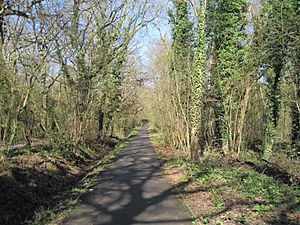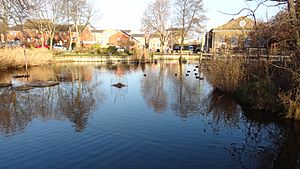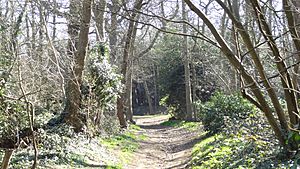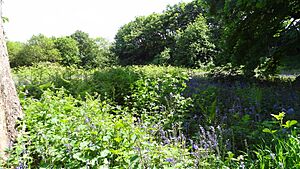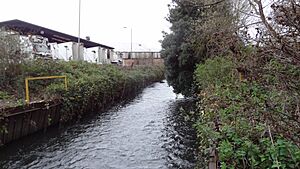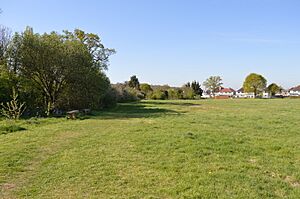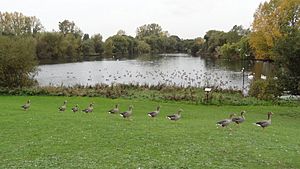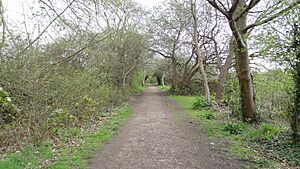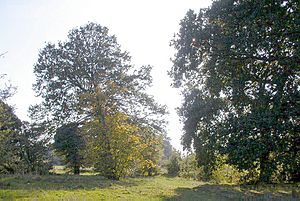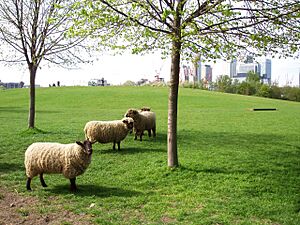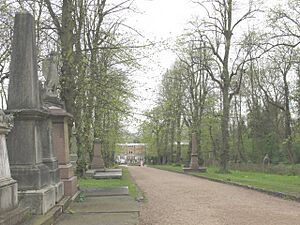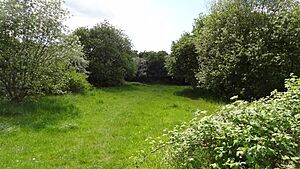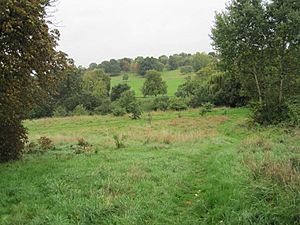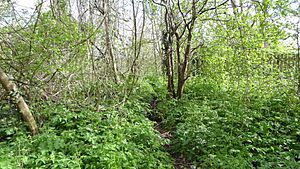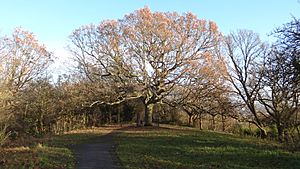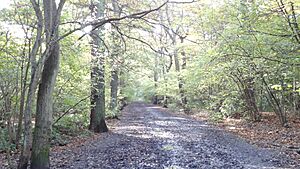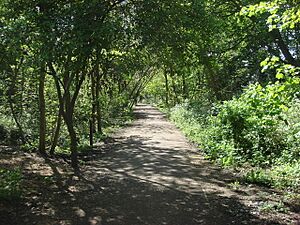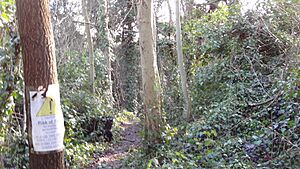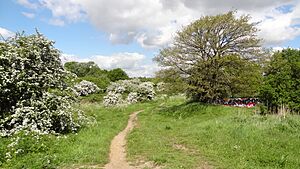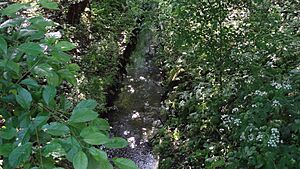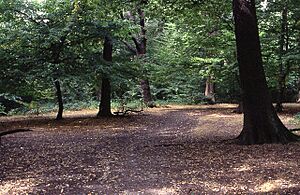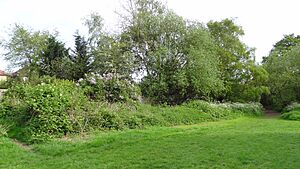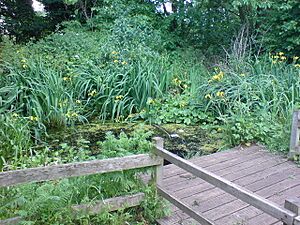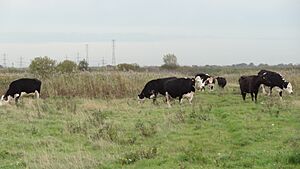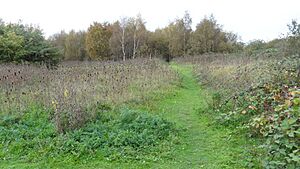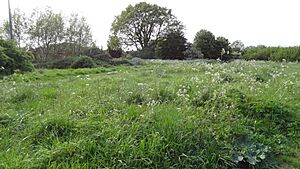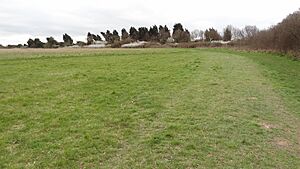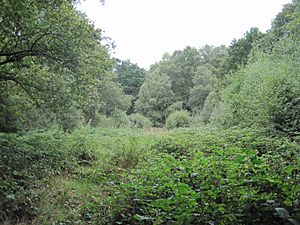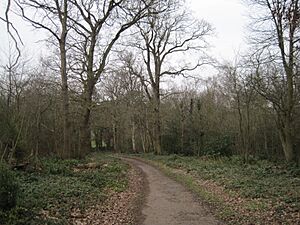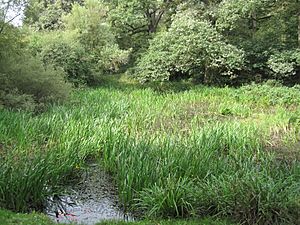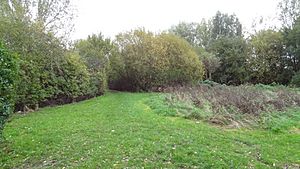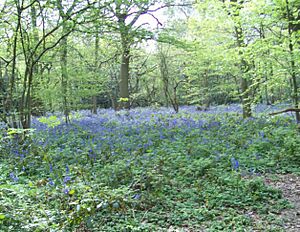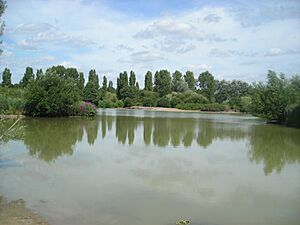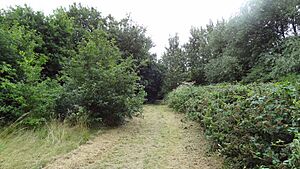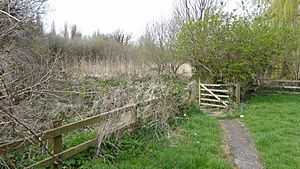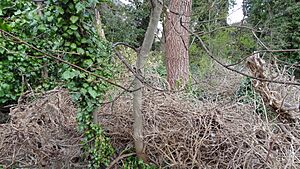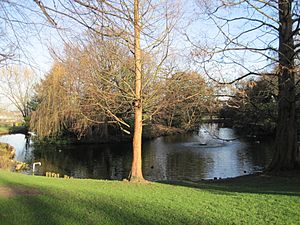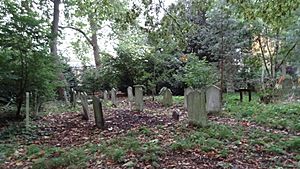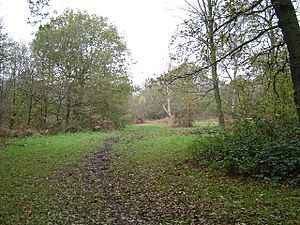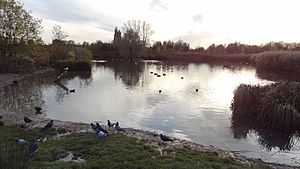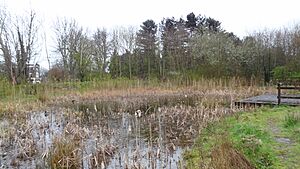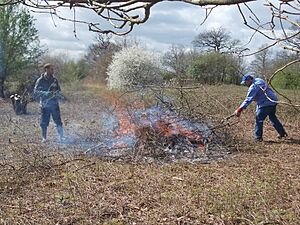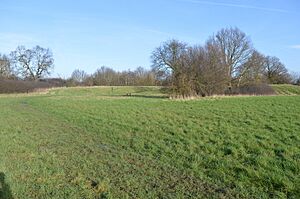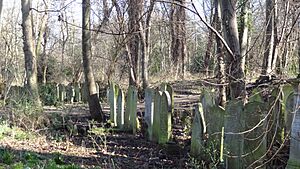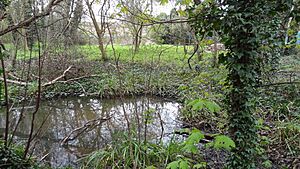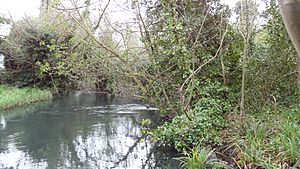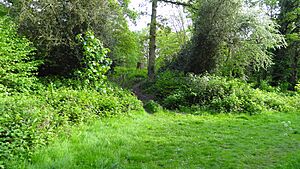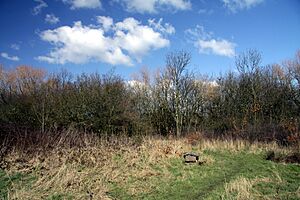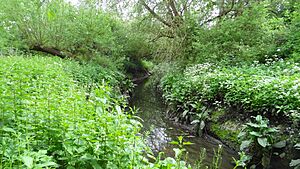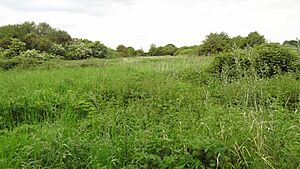List of local nature reserves in Greater London facts for kids
Greater London is one of the biggest cities in Europe. It covers about 1,572 square kilometers (607 square miles). This area was officially decided in 1965 when Greater London was created. It includes 32 London areas and the City of London. Amazingly, almost two-thirds of this huge city is made up of green spaces and wetlands! In 2011, about 8.17 million people lived here.
Imagine special places where nature is protected right in your city! These are called Local Nature Reserves (LNRs). Local councils set them up to keep wildlife habitats and natural areas safe. They can even make special rules to manage and protect these spots. To do this, the local council must own or rent the land, or have an agreement with the owner. As of January 2016, there were 144 Local Nature Reserves in Greater London.
The biggest LNR is Brent Reservoir, which is about 97.31 hectares (240 acres). It's super important for birds that live near water, like great crested grebes, and for its unique marsh plants. The smallest LNR is Burnt Ash Pond, only 0.13 hectares (0.32 acres). It's an old farm pond right in the middle of houses! The longest LNR is Parkland Walk, which stretches for 7.2 kilometers (4.5 miles) along an old railway line.
Some of these nature reserves have a long history. Perivale Wood is one of the oldest in Britain. People have been looking after it since 1902, and it became an LNR in 1974. The newest LNRs were created in 2013. These include Coldfall Wood, Alexandra Palace and Park, and Masons Field. Many of these amazing places, like Camley Street Natural Park in Kings Cross and Frays Valley, are looked after by the London Wildlife Trust.
Discover London's Local Nature Reserves
| Top - 0-9 A B C D E F G H I J K L M N O P Q R S T U V W X Y Z |
London's Local Nature Reserves are fantastic places to explore nature. Each one is special and offers something different, from ancient woodlands to peaceful ponds. Here are some of them:
Abney Park Cemetery
This historic cemetery in Hackney is one of London's "Magnificent Seven" cemeteries. It stopped being used for burials in 1978. Now, it's a peaceful nature reserve, covering about 12.54 hectares (31 acres). It's a great place to see nature and history together.
Ackroyd Drive Greenlink
The Greenlink is a special green path in Tower Hamlets. It connects Tower Hamlets Cemetery and Mile End Park. This small reserve, about 0.87 hectares (2.1 acres), helps wildlife move safely through the city.
Adelaide Nature Reserve
Located in Camden, this 0.90 hectare (2.2 acre) nature reserve slopes down towards a railway line. It has mostly grassy areas, with some bushes and trees. You can visit at certain times.
Ainslie Wood
In Waltham Forest, Ainslie Wood is an ancient woodland. It has old oak trees and wild service trees. Locals call it Bluebell Wood because of the beautiful bluebells that bloom in spring. It's about 2.06 hectares (5.1 acres).
Alexandra Palace and Park
This large park in Haringey is about 62.66 hectares (154.8 acres). It has many different natural areas, which is unusual for a city park. It's especially known for its many types of birds.
Anton Crescent Wetland
This wetland in Sutton is about 1.04 hectares (2.6 acres). It's used by the Environment Agency to store water during floods. It has open water, tall reed beds, and willow trees. Public access is not allowed here.
Barnes Common
Barnes Common in Richmond is a big area, about 41.68 hectares (103 acres). It's mostly wooded, with some grassy spots. Trees like plane, lime, and horse chestnut were planted here a long time ago.
Barnsbury Wood
This small wood in Islington is only 0.32 hectares (0.79 acres). It used to be a vicarage garden. It's mainly filled with sycamore, ash, and lime trees. You can visit at limited times.
Battersea Park Nature Areas
These nature areas within Battersea Park in Wandsworth cover about 2.90 hectares (7.2 acres). They have mixed woodlands, bushy areas, four open clearings, and a pond. You might spot over twenty types of butterflies here!
Beam Valley Country Park
This park in Barking and Dagenham is on the banks of the River Beam. It's about 39.29 hectares (97.1 acres). You can also find old military features like "dragon's teeth" and "pillboxes" here. A smaller part, 11.86 hectares (29.3 acres), is managed by the Environment Agency as a separate LNR.
Beckenham Place Park
In Lewisham, Beckenham Place Park is a huge 95.14 hectares (235.1 acres). It has lots of ancient woodland, different kinds of grassland, a natural part of a river, and an old pond.
Bedfont Lakes Country Park
This park in Hounslow is about 31.59 hectares (78.1 acres). It has lakes that were created from an old landfill site. There are also grassy areas and woodlands.
Bedfords Park
Bedfords Park in Havering is a very large site, 106.35 hectares (262.8 acres). It features wildflower meadows, diverse woodlands, several ponds, a lake, and even a herd of red deer. The Essex Wildlife Trust helps manage it.
Belmont Pastures
These pastures in Sutton are about 1.26 hectares (3.1 acres). They are made up of grassland and scrub. You can find a wide variety of crickets, butterflies, and grasshoppers here.
Belsize Wood
Belsize Wood in Camden is a small, sloping wooded area of 0.27 hectares (0.67 acres). It has old oak trees and many different insect species. Only parts of it are open to the public at certain times.
Bennett's Hole
This reserve in Merton is 1.22 hectares (3.0 acres). It has different natural areas like woodland, marsh, and scrub. The northern part has many tree types, while the south has mostly crack willows and oaks.
Bentley Priory
Bentley Priory in Harrow is a big site, 59.25 hectares (146.4 acres). It's a Site of Special Scientific Interest (SSSI) because of its important meadows. It also has large woods and two ponds.
Big Wood and Little Wood
These two small woods in Barnet are what's left of the ancient forest that once covered north London. They are 8.29 hectares (20.5 acres) in total. You might see birds here that are rare in London, like the green woodpecker.
Blondin Park, Northfields
The nature area of this park in Ealing is 2.34 hectares (5.8 acres). It has a pond, an orchard (fruit tree garden), and a wildflower meadow.
Bonesgate Open Space
This 5.07 hectare (12.5 acre) park in Kingston follows the bank of the Bonesgate Stream. It has parkland with hazel trees and many types of breeding birds.
Bramley Bank
Bramley Bank in Croydon is 10.30 hectares (25.5 acres). It has oak and ash woodland with a large pond, and areas of acidic grassland. The London Wildlife Trust helps manage it.
Brent Reservoir/Welsh Harp
This is the largest LNR, covering 97.31 hectares (240.5 acres) across Barnet and Brent. Most of it is a Site of Special Scientific Interest (SSSI). It's especially important for its many breeding birds, like the great crested grebe.
Brookmill Road
This reserve in Lewisham is a steep, unused railway embankment, 0.44 hectares (1.1 acres). It's a woodland with mostly hornbeam and hazel trees. It's not open to the public.
Burnt Ash Pond
The smallest LNR, this pond in Lewisham is only 0.13 hectares (0.32 acres). It's surrounded by houses but is home to many water animals, including breeding toads, and plants like great and hoary willowherb. Public access is not allowed.
Camley Street Natural Park
This 0.84 hectare (2.1 acre) nature reserve is on the bank of Regents Canal in Kings Cross, Camden. It has ponds, meadows, and woodlands. You might see birds like reed warblers and kingfishers. The London Wildlife Trust manages it.
Cannon Hill Common
Cannon Hill Common in Merton is 14.16 hectares (35.0 acres). It has meadows with plants like meadow barley and meadow foxtail, and woodlands with old oak trees.
Castle Hill
This 3.48 hectare (8.6 acre) woodland in Kingston is the site of a medieval hunting lodge. It's mostly oak and hazel trees, with many ground plants like wood anemone. It's also a Scheduled monument.
The Chase Nature Reserve (Barking and Havering)
The Chase is a footpath along the River Rom. The part in Barking and Dagenham is 44.15 hectares (109.1 acres) and has diverse habitats. You might spot water voles here. The part in Havering is 1.39 hectares (3.4 acres) and has black poplar trees.
Cherry Wood
In Merton, Cherry Wood is 1.76 hectares (4.3 acres). Its main trees are pedunculate oak, ash, and horse chestnut. Over twenty-five types of birds live here.
Chiswick Eyot
This small wooded island in the Thames in Hounslow is 0.83 hectares (2.0 acres). It's mostly willow trees and is surrounded by reed beds. Public access is not allowed.
Coldfall Wood
Coldfall Wood in Haringey is an ancient woodland, 13.43 hectares (33.2 acres). It has hornbeam, oak, birch, and sycamore trees. Some ground plants here are rare in London, like pale sedge and lady-fern.
Coombe Hill Wood
This wood in Kingston is 2.19 hectares (5.4 acres). It's mainly oak trees with a lower layer of hazel bushes that are cut back regularly (coppice).
Coppetts Wood and Glebelands
These two areas in Barnet together cover 20.00 hectares (49.4 acres). Coppetts Wood has mostly oak and hornbeam trees and is home to rare insects. Glebelands is a leftover part of an old common, with woodland and ponds.
Covert Way
Covert Way in Enfield is a 6.77 hectare (16.7 acre) deciduous woodland. You might see muntjac deer, green and greater spotted woodpeckers, and special butterflies like white-letter and purple hairstreaks.
Crane Park Island
This island in the River Crane in Richmond is 2.67 hectares (6.6 acres). It has wet woodland, grassland, and reed beds. Kingfishers and water voles live here. The London Wildlife Trust manages it.
Cranebank, Hatton
Cranebank in Hounslow is 6.69 hectares (16.5 acres) of flood meadows by the River Crane. They get covered in water in winter. You can find twenty-six types of butterflies and twelve types of dragonflies and damselflies here.
Cranham Brickfields
This site in Havering is 8.69 hectares (21.5 acres). It has grassy areas, a pond, bushes, and woodland. You might see great crested newts and slowworms, and plants like dyer's greenweed.
Cranham Marsh
Cranham Marsh in Havering is 12.97 hectares (32.0 acres). It has marshes, ponds, and ancient woodland. A small river, a tributary of the River Markyke, flows through it. The Essex Wildlife Trust helps manage it.
Cranmer Green
This green space in Merton is 3.22 hectares (8.0 acres). It has a pond, woodland, and grassland. The pond is probably from the late 1700s.
Crossness
Crossness in Bexley is a large area of 25.50 hectares (63.0 acres). It has many open water areas and ditches, with some rough grassland. Over 130 types of birds have been seen here. Only parts of it are open to the public.
Cuddington Meadows
Cuddington Meadows in Sutton is 1.39 hectares (3.4 acres) of chalk grassland. It's important for its many different flowering plants. Sixteen types of butterflies have been recorded here.
Dacres Wood
This wood in Lewisham is 0.70 hectares (1.7 acres). It has some huge turkey oaks and pretty shrubs that might be from a Victorian garden. There are also marshes and a pond. Public access is limited.
Dagenham Village Churchyard
This churchyard in Barking and Dagenham is 0.87 hectares (2.1 acres). The old gravestones and walls are home to lichens and mosses. Woodpeckers feed in the rows of lime trees.
Danson Park Bog Garden, Welling
Danson Park in Bexley has a large lake. A marshy area at its western end, 1.07 hectares (2.6 acres), has been turned into a nature reserve.
Denham Country Park
This park, partly in Hillingdon and partly in Buckinghamshire, is 19.82 hectares (49.0 acres). Three rivers flow through it: the Colne, the Misbourne, and the Frays. You might see herons and kingfishers here.
Derwent Floodwash
This 1.83 hectare (4.5 acre) area in Merton is designed to hold water when Pyl Brook floods, to prevent flooding downstream. It's a wet grassland with some unusual plant species.
Devonshire Avenue Nature Area
This 0.42 hectare (1.0 acre) area in Sutton is mostly chalk grassland. It's home to the locally rare small blueall blue butterfly and its food plant, kidney vetch.
Downham Woodland Walk
The walk in Lewisham is an ancient woodland, 2.82 hectares (7.0 acres). It has pedunculate oaks, hornbeams, and field maples. You can also find insects like stag and fungus beetles.
Duke's Hollow
Duke's Hollow in Hounslow is 0.27 hectares (0.67 acres) and slopes steeply down towards the Thames. It's a woodland mainly made up of willow trees.
Dulwich Upper Wood
This wood in Southwark is 1.74 hectares (4.3 acres) and is a remnant of the old Great North Wood. It's mainly oak trees, and animals like stag beetles and bats live here.
Eastbrookend Country Park
Eastbrookend Country Park in Barking and Dagenham is a huge 67.39 hectares (166.5 acres). It used to be abandoned land but was planted with 50,000 small trees and special grass and flower seeds.
Edith Gardens
This 0.44 hectare (1.1 acre) site in Kingston used to be allotments next to Tolworth Brook. It's mostly grassland, with some young elm trees, brambles, and large old trees. Public access is not allowed.
Elmbridge Open Space
This 9.35 hectare (23.1 acre) green walk in Kingston follows the bank of the Hogsmill River. There are willow trees by the river and plants like meadowsweet and comfrey.
Fishpond Wood and Beverley Meads
These areas in Merton cover 5.92 hectares (14.6 acres). Fishpond Wood has wetlands and oak and hazel woodlands. Beverley Meads has a mix of woods and pastures. The London Wildlife Trust helps manage it.
Foots Cray Meadows
Foots Cray Meadows in Bexley is 30.32 hectares (74.9 acres). The River Cray flows through it. It has a varied landscape, including ancient woodlands and wildflower meadows.
Fox Wood
Fox Wood in Ealing is 2.25 hectares (5.6 acres). It used to be a reservoir but was drained during World War II so German bombers couldn't use it for navigation. Now it's a sloping woodland.
Foxley Wood, Purley
Foxley Wood in Croydon is 11.36 hectares (28.1 acres). It has chalk grassland and woods. You might see badgers and roe deer, and over forty types of birds have been spotted here.
Frays Valley
Frays Valley in Hillingdon is a large, wildlife-rich valley of 71.87 hectares (177.6 acres). The Frays River flows through it. You can find plants like kingcups and ragged robin, and mammals like harvest mice and water voles. It's a Site of Special Scientific Interest (SSSI) and managed by the London Wildlife Trust.
Fryent Country Park
Fryent Country Park in Brent is a huge 106.97 hectares (264.3 acres). It has a varied landscape with lakes, woodland, and meadows. Over 800 species have been recorded here, including 80 birds and 21 butterflies.
Gillespie Park
Gillespie Park in Islington is 3.03 hectares (7.5 acres). It has an ecology center and is mostly grassland. Birds like reed buntings and song thrushes live here, and its ponds have many water insects.
Grove Farm, Ealing
Grove Farm in Ealing is 8.07 hectares (19.9 acres). It has ancient woodland with wild service trees and many different wild flowers.
Gunnersbury Triangle
This reserve, 2.57 hectares (6.4 acres), is located in both Hounslow and Ealing. It has different natural areas, including woodland and marshes. You can find amphibians like toads, newts, and frogs here. The London Wildlife Trust manages it.
Hainault Lodge
Hainault Lodge in Redbridge is 5.60 hectares (13.8 acres) of ancient woodland and pasture. You might see butterflies like orange tips and speckled woods, and birds like long-tailed tits and robins. Public access is not allowed.
Ham Common
Ham Common in Richmond is 40.27 hectares (99.5 acres). The main trees are birch and oak, and there are also areas of acidic grassland.
Ham Lands
Ham Lands in Richmond is a large area of 60.01 hectares (148.3 acres). It used to be a gravel quarry filled with different types of soil from across London. This created a unique mix of natural areas.
High Elms
High Elms in Bromley is a huge 102.33 hectares (252.9 acres). Most of this country park is woodland that grew back after being cleared. It still has many of its original ground plants, including some rare types. It's also a Site of Special Scientific Interest (SSSI).
Hogsmill River Park
This linear park in Kingston follows the Hogsmill River. It's 22.26 hectares (55.0 acres) and has a varied landscape with grassy areas and old willow and oak woodlands.
Hounslow Heath
Hounslow Heath in Hounslow is a vast 83.14 hectares (205.4 acres). It has large areas of acidic grassland, some hay meadows, marshland, and woodland.
Hutchinson's Bank
Hutchinson's Bank in Croydon is a sloping meadow bank, 21.77 hectares (53.8 acres). It has a diverse ecology, including pyramidal and common spotted orchids, and the rare greater yellow-rattle. The London Wildlife Trust helps manage it.
Ingrebourne Valley
Ingrebourne Valley in Havering is a massive 146.62 hectares (362.3 acres). It has a wide range of natural areas: rough grassland, woodland, marshes, a river, reedbeds, and wet grazing land. You can find great crested newts, slowworms, and harvest mice here. It's a Site of Special Scientific Interest (SSSI) and managed by the Essex Wildlife Trust.
Isleworth Ait
This island in the Thames in Hounslow is 3.49 hectares (8.6 acres). It has poplar and willow woodland on land that often floods. Rare species like the two-lipped door snail and the German hairy snail live here. Public access is not allowed. The London Wildlife Trust manages it.
Islip Manor Meadows
Islip Manor Meadows in Ealing is a diverse wet meadow site of 23.75 hectares (58.7 acres). It has over twenty types of grass and ten leguminous (bean family) plants. There are ponds with the protected great crested newt.
Jubilee Country Park
Jubilee Country Park in Bromley is 28.67 hectares (70.9 acres). It has chalk grassland and woods with oaks, hawthorns, and field maples. Some species found here are rare in London.
Jubilee Wood, Malden Rushett
Trees in this 2.24 hectare (5.5 acre) wood in Kingston include birch, pedunculate oak, field maple, goat willow, and wych elm.
Kempton Park Reservoirs
Kempton in Hounslow is 22.80 hectares (56.3 acres) of disused reservoirs. It's a Site of Special Scientific Interest (SSSI) and important for its many bird species, especially for gadwall ducks in winter. Bats feed here, and mammals include water voles. Public access is not allowed.
Lavender Pond
Lavender Pond in Southwark is 0.70 hectares (1.7 acres). It used to be part of the Surrey Commercial Docks but is now a small wildlife pond. Only parts of it are open to the public.
Lesnes Abbey Woods
Lesnes Abbey Woods in Bexley is a large site of 73.13 hectares (180.7 acres). It has ancient woodland, parkland, heath, wetland, and hedgerows. A survey found 906 types of insects, 46 birds, 12 mammals, 59 fungi, and 292 plants! It's also a Site of Special Scientific Interest (SSSI).
Litten Nature Reserve
Litten in Ealing is 10.7 hectares (26 acres). It has a pond, woodland, and a wildflower meadow.
Long Wood, Ealing
Long Wood in Ealing is 1.20 hectares (3.0 acres) of ancient woodland. It has many different types of trees and wildlife.
Lonsdale Road Reservoir (Leg of Mutton Reservoir)
This disused reservoir in Richmond is 8.19 hectares (20.2 acres). It's home to a wide variety of water birds, including tufted ducks and wigeons.
Lower Wandle
This 2.52 hectare (6.2 acre) stretch of the River Wandle in Merton is lined with old trees, grassland, and patches of herbs.
The Manor (Dagnam Park)
The Manor in Havering is a large area of 67.96 hectares (168.0 acres). It includes several parks and different natural areas. Plants here include the common spotted-orchid and square stemmed St John's wort.
Maryon Wilson Park and Gilbert's Pit
These areas in Greenwich cover 17.52 hectares (43.3 acres). Gilbert's Pit is a special geological site (SSSI). Maryon Wilson Park is a hilly, wooded area with a stream and rare plants. Maryon Park has acidic grassland, bushes, and woodland that grew back naturally.
Masons Field
Masons Field in Brent is 2.87 hectares (7.1 acres). It used to be a sports ground for the London Underground but has been turned into a wildflower meadow next to Fryent Country Park.
Mayesbrook Park South
The nature reserve part of Mayesbrook Park in Barking and Dagenham is 7.55 hectares (18.7 acres). It has two large lakes, rough grassland, and woodland.
Merton Park Green Walks
This 1.49 hectare (3.7 acre) site in Merton has different natural areas, including grassland and an area of elm bushes and brambles that is hard to reach.
Morden Park
Morden Park in Merton is 28.19 hectares (69.7 acres). It has woodland with 300-year-old oak trees. Birds like coal tits and spotted flycatchers live here.
Mudchute Park and Farm
Mudchute Park and Farm in Tower Hamlets is a city farm and nature reserve, 13.31 hectares (32.9 acres). It has varied natural areas, including wetlands. You can find insects like smooth newts and slowworms here.
Myrna Close
Myrna Close in Merton is a 0.75 hectare (1.9 acre) linear park along an old railway line. It has a small stream, two ponds, and wetland plants like brooklime.
New Cross Gate Cutting (Brockley Nature Reserve)
This sloping railway cutting in Lewisham is 4.2 hectares (10 acres). It's mostly woodland with some grassy areas, reeds, and herbs. Over 170 plant species have been found here, some of which are unusual for the area. Public access is not allowed. The London Wildlife Trust manages it.
Northolt Manor
Northolt Manor in Ealing is 1.79 hectares (4.4 acres). It was a moated manor house from the 1300s. It has wetland, scrub, woodland, and grassland. The wetland has many species, like thread-leaved water-crowfoot and narrow-fruited water-cress. It's also a Scheduled Monument.
Nunhead Cemetery
Nunhead Cemetery in Southwark is 20.23 hectares (50.0 acres) and is one of London's "Magnificent Seven" cemeteries. It has many different plants, and sixteen types of butterflies have been recorded here.
Oak Avenue, Hampton
Oak Avenue in Richmond is 1.85 hectares (4.6 acres) of former wasteland. New natural areas like meadows and a pond have been created here, and others have grown naturally.
Oak Hill Wood
This medieval oak wood in Barnet is 9.88 hectares (24.4 acres). It has wild service trees, woodland flowers like wood anemones and yellow archangels, and bats like pipistrelles and brown long-eared bats. The London Wildlife Trust manages it.
Oakleigh Way
Oakleigh Way in Merton is a 0.64 hectare (1.6 acre) former railway depot that has been turned into a nature reserve. It has birch woodland and wildflower meadows.
One Tree Hill
One Tree Hill in Southwark is 6.95 hectares (17.2 acres). Queen Elizabeth I is said to have had a picnic under an oak tree at the top of this hill. It has many very old trees.
Oxleas/Shooters Hill Woodlands
These woods in Greenwich cover a large area of 119.60 hectares (295.6 acres). They have many different types of fungi and insects, including the rare palmate newt. Oxleas Wood itself is over 8,000 years old! It's also a Site of Special Scientific Interest (SSSI).
Parkland Walk
Parkland Walk is a 14.31 hectare (35.4 acre) walk in Haringey and Islington. It's 4.5 miles long and follows an old railway line. It has an area of acidic grassland with rare plants and insects.
Parsloes Park Squatts
This 4.28 hectare (10.6 acre) area in Barking and Dagenham is a part of the park with neutral and acidic grassland that has been set aside as a nature reserve. It has ancient hedgerows.
Perivale Wood
Perivale Wood in Ealing is 8.02 hectares (19.8 acres) of ancient woodland with oak and ash trees. It also has rough grassland, ponds, and streams. Public access is not allowed.
Pevensey Road Nature Reserve
Pevensey Road in Hounslow is 10.21 hectares (25.2 acres). It's an area of scrub, woodland, and wetland next to the River Crane.
Pyl Brook
This 1.31 hectare (3.2 acre) stretch of Pyl Brook and the land next to it in Merton is mostly old hawthorn and elm bushes.
Queen's Wood
Queen's Wood in Haringey is 21.07 hectares (52.1 acres). The wood is mainly oak and hornbeam trees. Over a hundred types of spiders have been found here.
Raeburn Open Space
Raeburn Open Space in Kingston is 5.00 hectares (12.4 acres). The Tolworth Brook flows through this site, which has young woodland, old hedgerows, and rough grassland.
Railway Fields
Railway Fields in Haringey is 0.87 hectares (2.1 acres). It has different natural areas, including a pond, marshland, a meadow, and woodland. Over 200 types of wild flowers have been recorded here. Public access is limited.
Rainham Marshes
Rainham Marshes in Havering is a large area of 79.19 hectares (195.7 acres). The grasslands here have rare plants, insects, and birds, and a large population of water voles. It's a Site of Special Scientific Interest (SSSI) and managed by the RSPB.
Ravensbury Park
Ravensbury Park in Merton is 7.04 hectares (17.4 acres). It's next to the River Wandle and has wetland bird species like kingfishers and grey wagtails, along with woodland areas.
Ripple Nature Reserve
Much of Ripple Nature Reserve in Barking and Dagenham is damp grassland, 3.68 hectares (9.1 acres). Drier areas have rare species like yellow vetchling. There are also some rare insect species, including the emerald damselfly.
Rose Walk
Rose Walk in Kingston is 2.69 hectares (6.6 acres) of unmanaged grassland with wild flowers. The main grasses are oat grass, tall fescue, and rye-grass.
Roundshaw Downs
Roundshaw Downs in Sutton is 19.61 hectares (48.5 acres) of chalk downland and woodland. It has many different bird species, including great spotted woodpeckers.
Rowley Green Common
This common in Barnet is 5.82 hectares (14.4 acres). It's mainly oak and birch woodland, with some grassland. It also has a sphagnum bog, which is rare in south-east England.
Ruffett and Big Woods
These woods in Sutton cover 7.01 hectares (17.3 acres). Ruffett Wood has many sycamores and some old wild cherries. Big Wood is mostly sycamores. The ground plants are very diverse.
Ruislip Local Nature Reserve
Ruislip Local Nature Reserve in Hillingdon is 4.42 hectares (10.9 acres). The woods have a mix of woodland, willow carr (wet, swampy woodland), and open heath. It's both a National Nature Reserve and a Site of Special Scientific Interest (SSSI). Public access is not allowed.
Scadbury Park
Scadbury Park in Bromley is a large area of 117.02 hectares (289.2 acres). It has lots of ancient woodland, neutral grassland, and pasture land that is rented out to a farmer.
Scratchwood and Moat Mount Open Space
These areas in Barnet cover 55.16 hectares (136.3 acres). Scratchwood has ancient oak and hornbeam woodland. Moat Mount has open grassy areas and woodland.
Scrattons Ecopark and extension
This 1.92 hectare (4.7 acre) site in Barking and Dagenham used to be allotments. It was turned into an ecopark to create different natural areas for plants and animals. Only parts of it are open to the public.
Selsdon Wood
Selsdon Wood in Croydon is 78.96 hectares (195.1 acres). It used to be a shooting estate but is now open pasture and woodland with a Memorial Pond.
Sir Joseph Hood Memorial Wood
This wood in Merton is 1.66 hectares (4.1 acres). It has a variety of birds and tree species.
South Norwood Country Park
South Norwood Country Park in Croydon is 43.55 hectares (107.6 acres). The park has a lake and meadows. Over a hundred types of birds have been seen here.
Southwood Open Space
This 12.91 hectare (31.9 acre) linear park in Kingston runs along the Hogsmill River. It's mainly meadow with elm bushes.
Spencer Road Wetlands
Spencer Road Wetlands in Sutton is 1.05 hectares (2.6 acres) and is next to the River Wandle. It has natural areas like reed swamp, willow Carr (wet woodland), a sedge bed, and a pond. Public access is not allowed. The London Wildlife Trust manages it.
The Spinney, Carshalton
The Spinney in Sutton is 0.40 hectares (0.99 acres). It's mainly sycamore and London plane trees. Breeding birds like dunnocks and wrens live here. Public access is not allowed.
Springfield Park
Springfield Park in Hackney is 13.59 hectares (33.6 acres). It's a special geological site and has diverse natural areas with fifty-six types of birds.
St. John's Wood Church Grounds
This closed cemetery in Westminster is 1.99 hectares (4.9 acres). It has a wildlife area, trees, and a formal garden.
Stanmore Common
Stanmore Common in Harrow is 49.2 hectares (122 acres). The common has heathland and woodland. It also has two old village ponds, one of which still has a pump.
Stanmore Country Park
Stanmore Country Park in Harrow is 30.73 hectares (75.9 acres). It has large areas of acidic grassland, mainly common bent and Yorkshire fog grasses. The woodland here is quite young.
Streatham Common
Streatham Common in Lambeth is 13.77 hectares (34.0 acres). The common has woodland mainly of oak trees, with others like sycamore and beech. A damp area has rare plants.
Sue Godfrey Nature Park
Sue Godfrey Nature Park in Lewisham is 0.60 hectares (1.5 acres). It became a nature park in 1984 after local people campaigned for it. It has over two hundred types of flowers, trees, and shrubs.
Sutcliffe Park
Sutcliffe Park in Greenwich is 5.86 hectares (14.5 acres). The River Quaggy flows through this park, which also has wetlands and a lake with many reed beds.
Sutton Ecology Centre Grounds
The grounds of the Sutton Ecology Centre in Sutton are 1.33 hectares (3.3 acres). It has a plane tree that is listed as one of the "Great Trees of London." A pond here has damselflies and dragonflies.
Sydenham Hill Wood and Fern Bank
Sydenham Hill Wood and Fern Bank in Southwark is 28.17 hectares (69.6 acres). It's a mix of ancient and newer woodland, with Victorian garden plants like a monkey puzzle tree.
Ten Acre Wood
Ten Acre Wood in Hillingdon is an oak plantation. It also has hawthorns and blackthorns, which provide berries for birds. The London Wildlife Trust manages it.
Tolworth Court Farm Fields
Tolworth Court Farm Fields in Kingston is 43.31 hectares (107.0 acres). This site has been farmed for a very long time, since the Domesday Book. It's now managed as neutral hay meadows. The damp northern field has plants typical of fields that are sometimes waterlogged, like creeping bent and marsh foxtail.
Totteridge Fields
Totteridge Fields in Barnet are ancient hay meadows, 6.92 hectares (17.1 acres). They have hawthorn and blackthorn hedgerows, which are great nesting spots for birds. The London Wildlife Trust manages them.
Tower Hamlets Cemetery Park
This closed 19th-century cemetery in Tower Hamlets is 11.60 hectares (28.7 acres). It has ancient woodland and grassy areas planted with wild flowers.
Wandle Meadow Nature Park
Wandle Meadow Nature Park in Merton is 3.44 hectares (8.5 acres). This site has woodland, wet grassland, and temporary ponds. Birds like bullfinches, whitethroats, and reed buntings breed here.
Wandle Valley Wetland
This wetland in Sutton is 0.63 hectares (1.6 acres). It's home to frogs, toads, and newts, and brown hawker dragonflies. Public access is not allowed.
Westbere Copse
The main trees in Westbere Copse in Camden are sycamore, oak, ash, and aspen. It also has smaller plants like snowberry, elder, and elm. It's 0.39 hectares (0.96 acres) and public access is limited.
Wilderness Island
Wilderness Island in Sutton is an island in the River Wandle, 2.73 hectares (6.7 acres). It has diverse natural areas, including woods, ponds, wild flower meadows, and wetlands. The London Wildlife Trust manages it.
The Wood and Richard Jefferies Bird Sanctuary
This site in Kingston is 1.46 hectares (3.6 acres). It used to be the garden of a large Victorian house. It has ancient woodland and insects like stag beetles. Only parts of it are open to the public.
Wormwood Scrubs
The nature area in Wormwood Scrubs park in Hammersmith & Fulham is 13.40 hectares (33.1 acres). It has many different trees, including pedunculate oak and silver birch. Rare birds like marsh harriers and whinchats can be seen here. There are also meadows with many butterflies.
Yeading Brook Meadows
This 17.00 hectare (42.0 acre) meadow site along the Yeading Brook is managed by the London Wildlife Trust. It's located in both Ealing and Hillingdon. You can find insects like Roesel's bush-crickets and shield bugs here.
Yeading Woods (Gutteridge Wood and Meadows)
Yeading Woods in Hillingdon is 25 hectares (62 acres). This site has ancient oak and hazel woodland and wildflower meadows. The London Wildlife Trust manages it.
Map of London Boroughs
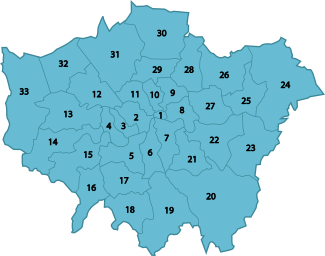 |
See also


